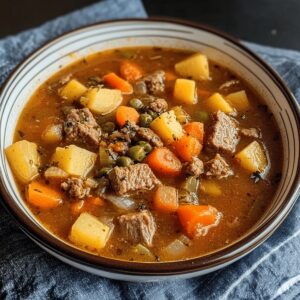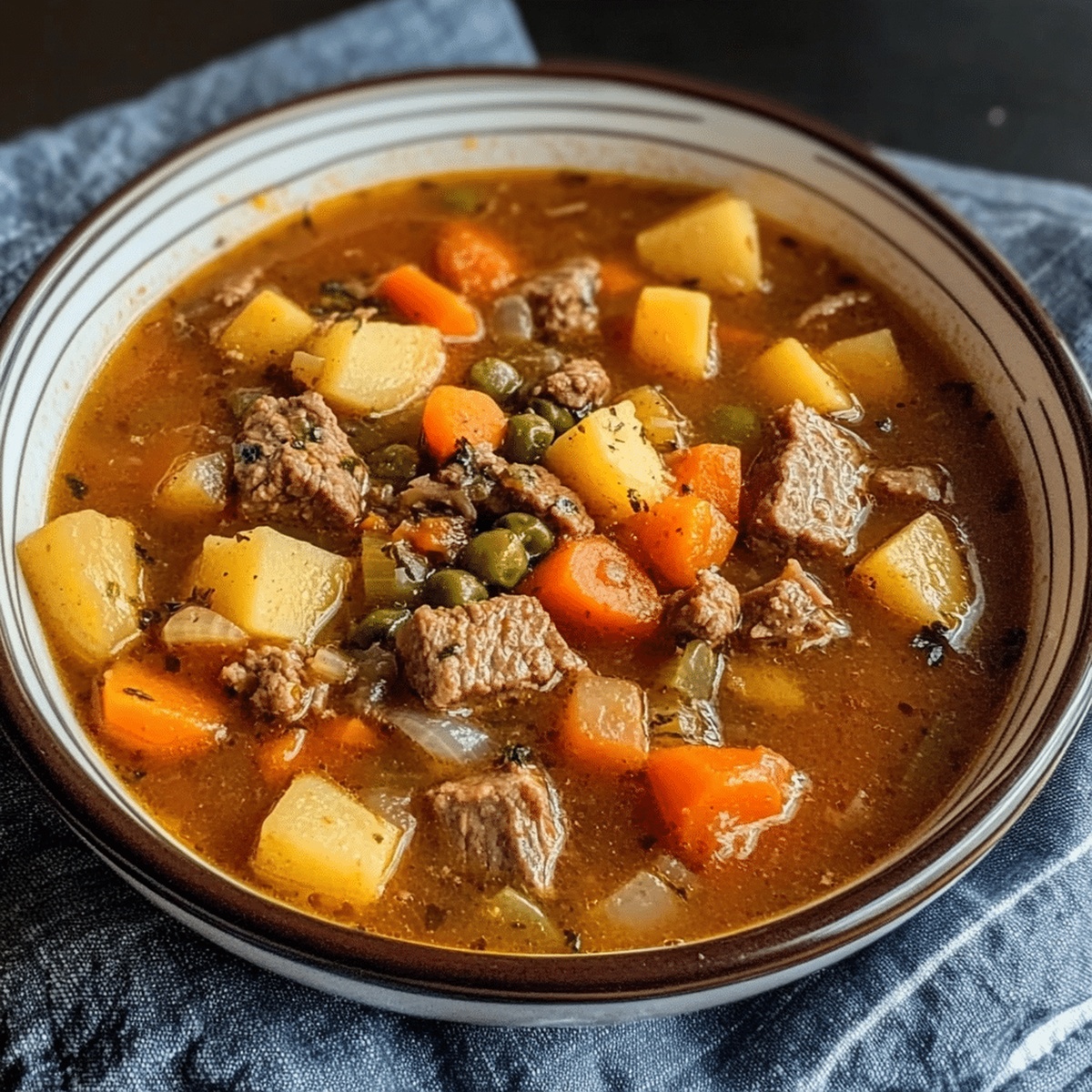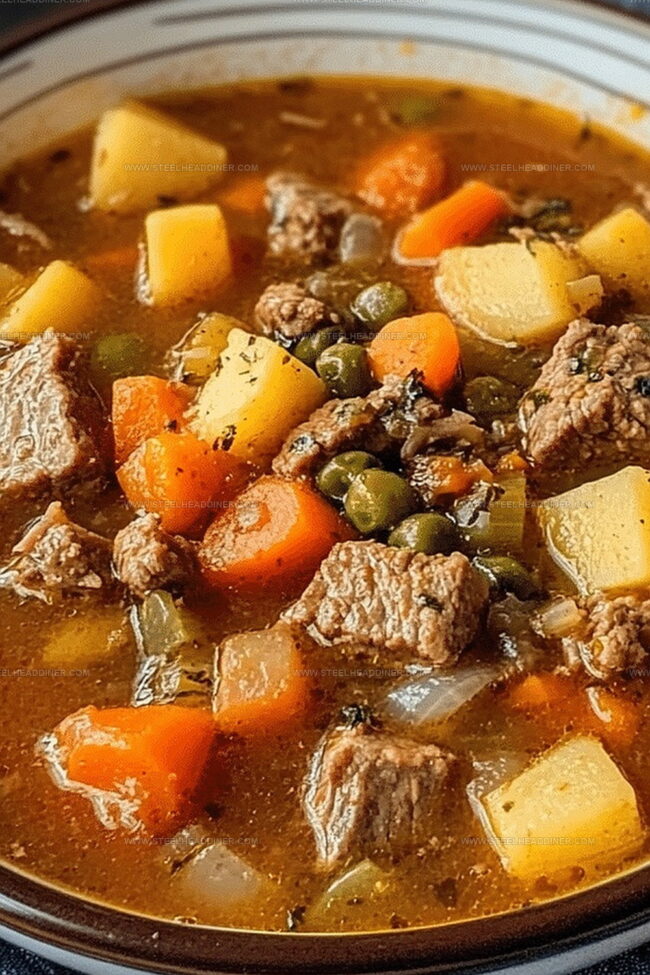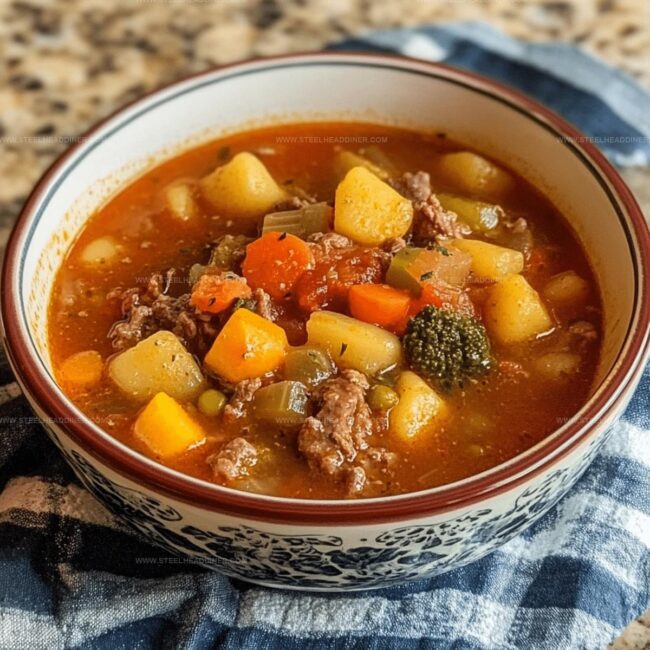Old-Fashioned Vegetable Beef Soup Recipe: Hearty Homemade Comfort
Grandma’s secret old-fashioned vegetable beef soup recipe brings comfort straight from her cozy kitchen to yours.
Memories of childhood winters flood back with each warm, hearty spoonful.
Tender chunks of beef mingle perfectly with seasonal vegetables, creating a deeply satisfying meal.
Slow-simmered ingredients release rich, complex flavors that warm you from the inside out.
Salt, pepper, and fresh herbs elevate this classic dish beyond simple sustenance.
Fragrant steam promises a delicious journey through traditional home cooking.
Ladle this soul-warming soup and savor every comforting bite.
Old-fashioned Vegetable Beef Soup Reasons To Try
Key Ingredients In Old-fashioned Vegetable Beef Soup
For the Protein:For the Base Vegetables:For the Additional Vegetables:For the Liquid:For the Seasoning:For the Garnish:For the Cooking Fat:Cooking Instructions For Vegetable Beef Soup
Step 1: Sear the Beef
Heat olive oil in a large pot over medium heat. Add beef stew meat and cook until golden brown on all sides.
This process locks in delicious flavors and creates a rich base for the soup. Transfer the seared meat to a separate plate.
Step 2: Prepare Aromatic Vegetables
In the same pot, sauté the following vegetables until they become soft and fragrant:The vegetables will release their natural sweetness and create a delightful foundation for the soup.
Step 3: Combine Ingredients
Return the seared beef to the pot.
Add the following ingredients:Step 4: Simmer and Develop Flavors
Bring the soup to a boil, then reduce heat to low. Allow the soup to simmer gently for 1.5 to 2 hours. This slow cooking process will tenderize the beef and blend all the wonderful flavors together.
Step 5: Season and Finish
Taste the soup and add salt and pepper according to your preference. Remove the bay leaves to prevent any bitter taste.
Step 6: Garnish and Serve
Sprinkle fresh chopped parsley on top for a burst of color and fresh flavor. Serve hot and enjoy your comforting soup.
Helpful Tips For Vegetable Beef Soup
Flavor Twists For Vegetable Beef Soup
Pairing Ideas For Vegetable Beef Soup
Storage Advice For Vegetable Beef Soup
FAQs
Chuck roast or stew meat are ideal because they become tender and flavorful when slow-cooked, breaking down nicely during the long simmering process.
Yes, after browning the meat and sauteing vegetables, transfer everything to a slow cooker and cook on low for 6-8 hours until beef is tender and vegetables are soft.
Add barley or small pasta like ditalini during the last 30 minutes of cooking to boost the soup’s heartiness and provide extra texture and substance.
Absolutely. The recipe combines protein from beef, multiple vegetables for vitamins and minerals, and provides a well-rounded meal with diverse nutrients in a single pot.
Print
Old-fashioned Vegetable Beef Soup Recipe
- Total Time: 2 hours 20 minutes
- Yield: 8 1x
Description
Hearty old-fashioned vegetable beef soup brings comfort and warmth to family dinners. Robust beef, tender vegetables, and savory broth create a classic meal you’ll crave on chilly evenings.
Ingredients
- 1 12 lb beef stew meat or chuck roast, cubed
- 8 cups (1.9 L) beef broth
- 2 tbsps olive oil
- 1 can (14.5 oz/411 g) diced tomatoes, undrained
- 4 medium potatoes, peeled and diced
- 3 large carrots, peeled and sliced
- 2 cups fresh or frozen green beans, trimmed and cut
- 3 stalks celery, chopped
- 1 large onion, finely chopped
- 1 cup fresh or frozen corn kernels
- 1 cup fresh or frozen peas
- 3 cloves garlic, minced
- 2 bay leaves
- Salt and pepper to taste
- Fresh parsley, chopped (for garnish)
Instructions
- Warm olive oil in a spacious pot over medium-high temperature, thoroughly searing beef stew meat until golden brown on each surface. Transfer meat to a separate plate.
- Utilize the identical pot to gently caramelize onions, minced garlic, diced carrots, and chopped celery until vegetables become translucent and fragrant.
- Reintroduce the browned meat into the vegetable mixture, then incorporate beef broth, diced tomatoes, cubed potatoes, sliced green beans, sweet corn kernels, tender peas, and aromatic bay leaves.
- Elevate heat to create a vigorous boil, then immediately reduce to a gentle simmer. Allow soup to slowly develop flavors for approximately 1.5-2 hours, ensuring meat becomes exceptionally tender and vegetables soften completely.
- After cooking duration, carefully season the soup with kosher salt and freshly cracked black pepper, adjusting to personal taste preferences.
- Methodically extract bay leaves from the soup to prevent bitter undertones.
- Finish the dish by sprinkling freshly chopped parsley across the surface, adding a vibrant herbaceous garnish before serving hot.
Notes
- Customize the soup’s consistency by adjusting broth quantity, creating a thicker or thinner texture based on personal preference.
- Choose lean beef cuts like chuck or sirloin for a healthier protein option with less fat content.
- Enhance nutritional value by adding extra vegetables like zucchini, spinach, or kale during the last 30 minutes of cooking.
- Freeze leftover soup in portion-sized containers for quick and convenient meals, maintaining flavor and texture up to 3 months.
- Prep Time: 20 minutes
- Cook Time: 2 hours
- Category: Lunch, Dinner, Appetizer
- Method: Simmering
- Cuisine: American
Nutrition
- Serving Size: 8
- Calories: 217 kcal
- Sugar: 3 g
- Sodium: 480 mg
- Fat: 9 g
- Saturated Fat: 2.5 g
- Unsaturated Fat: 6 g
- Trans Fat: 0 g
- Carbohydrates: 15 g
- Fiber: 3 g
- Protein: 20 g
- Cholesterol: 50 mg





Jack Monroe
Founder & Recipe Innovator
Expertise
Pacific Northwest cuisine, Single-serving recipe development, Sustainable sourcing and cooking, Modern comfort food
Education
Brightwater
Associate of Applied Science in Culinary Arts
Focus: Sustainable cooking, seasonal ingredients, and food systems education
Jack grew up with a fishing rod in one hand and a cast-iron skillet in the other. After graduating from Brightwater: A Center for the Study of Food, he set out to prove that cooking for one could still taste like a feast.
Jack believes that food should feel real: fresh, fearless, and a little wild, just like the rivers he grew up around. For Jack, every single dish is a small adventure, and the best ones are the ones you can cook with heart, not hassle.